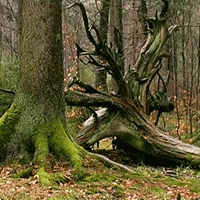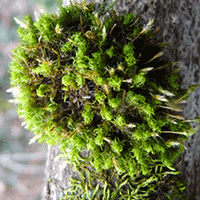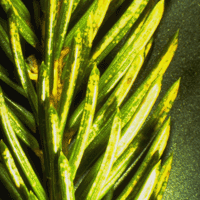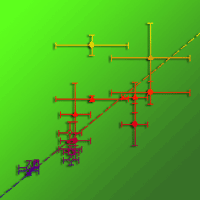The main goal of this study was to check whether the process of the colonization of coarse woody debris (CWD) is random or is determined by the wood traits and the environment. The study was conducted in the Karkonosze Mts., a part of Sudeten Mts. (Poland). We recorded the CWD traits and site conditions for 453 logs of spruce (Picea abies) and beech (Fagus sylvatica), which were either colonized or not colonized by vascular plants. Principal Components Analysis (PCA), a statistical comparison of two categories of logs using the Wilcoxon’s sum rank test and Generalized Linear Model (GLM) were applied. P. abies logs were colonized significantly more frequently than F. sylvatica logs. PCA demonstrated that the groups of colonized and non-colonized logs significantly differed overall in both species. The colonization status of a given log was significantly associated with CWD traits and site conditions. Decomposition class, the log diameter and the cover of bryophytes in F. sylvatica and P. abies, as well as altitude in the latter species, were significant factors that increased the probability of dead wood colonization by vascular plants. The results supported the hypothesis that vascular plants do not colonize all of the available logs and that the process of establishment is not random.
Keywords
, , , , ,
Citation
Chmura D, Zarnowiec J, Staniaszek-Kik M (2018). Comparison of traits of non-colonized and colonized decaying logs by vascular plant species. iForest 11: 11-16. - doi: 10.3832/ifor2107-010
Academic Editor
Gianluca Piovesan
Paper history
Received: May 08, 2016
Accepted: Oct 25, 2017
First online: Jan 09, 2018
Publication Date: Feb 28, 2018
Publication Time: 2.53 months
© SISEF - The Italian Society of Silviculture and Forest Ecology 2018
Open Access
This article is distributed under the terms of the Creative Commons Attribution-Non Commercial 4.0 International (https://creativecommons.org/licenses/by-nc/4.0/), which permits unrestricted use, distribution, and reproduction in any medium, provided you give appropriate credit to the original author(s) and the source, provide a link to the Creative Commons license, and indicate if changes were made.

Breakdown by View Type
(Waiting for server response...)
Article Usage
Total Article Views: 47802
(from publication date up to now)
Breakdown by View Type
HTML Page Views: 40805
Abstract Page Views: 2613
PDF Downloads: 3353
Citation/Reference Downloads: 17
XML Downloads: 1014
Web Metrics
Days since publication: 2897
Overall contacts: 47802
Avg. contacts per week: 115.50
Article Citations
Article citations are based on data periodically collected from the Clarivate Web of Science web site
(last update: Mar 2025)
Total number of cites (since 2018): 8
Average cites per year: 1.00
Publication Metrics
by Dimensions ©
Articles citing this article
List of the papers citing this article based on CrossRef Cited-by.
(1)
Brang P, Moran J, Puttonen P, Vyse A (2003)Regeneration of
Picea engelmannii and
Abies lasiocarpa in high-elevation forests of south-central British Columbia depends on nurse logs. The Forestry Chronicle 79 (2): 273-279.
CrossRef |
Gscholar
(2)
Bütler R, Patty L, Le Bayon RC, Guenat C, Schlaepfer R (2007)Log decay of
Picea abies in the Swiss Jura Mountains of central Europe. Forest Ecology and Management 242: 791-799.
CrossRef |
Gscholar
(3)
Checko E, Jaroszewicz B, Olejniczak K, Kwiatkowska-Falinska AJ (2015)The importance of coarse woody debris for vascular plants in temperate mixed deciduous forests. Canadian Journal of Forest Research 45 (9): 1154-1163.
CrossRef |
Gscholar
(4)
Chmura D (2008)The colonization of coarse woody debris of
Fagus sylvatica by forest herbs in Bukowica reserve (S Poland). Roczniki Akademii Rolniczej w Poznaniu Botanica Steciana 12: 3-7.
Gscholar
(5)
Chmura D (2014)Biology and ecology of an invasion of
Impatiens parviflora DC in natural and semi-natural habitats. Wydawnictwo ATH, Bielsko-Biala, Poland, pp. 216.
Gscholar
(6)
Chmura D, Zarnowiec J, Staniaszek-Kik M (2016)Interactions between plant traits and environmental factors within and among montane forest belts: a study of vascular species colonising decaying logs. Forest Ecology and Management 379: 216-225.
CrossRef |
Gscholar
(7)
Cornwell WK, Cornelissen JHC, Allison SD, Bauhus J, Eggleton P, Preston CM, Scarff F, Weedon JT, Wirth C, Zanne AE (2009)Plant traits and wood fates across the globe: rotted, burned, or consumed? Global Change Biology 15: 2431-2449.
CrossRef |
Gscholar
(8)
Dittrich S, Jacob M, Bade C, Leuschner C, Hauck M (2014)The significance of deadwood for total bryophyte, lichen, and vascular plant diversity in an old-growth spruce forest. Plant Ecology 215 (10): 1123-1137.
CrossRef |
Gscholar
(9)
During HJ, Tooren BF (1990)Bryophyte interactions with other plants. Botanical Journal of the Linnean Society 104 (1-3): 79-98.
CrossRef |
Gscholar
(10)
Harmon ME, Franklin JF, Swanson FJ, Sollins P, Gregory SV, Lattin JD, Anderson NH, Cline SP, Aumen NG, Sedell JR, Lienkaemper GW, Cromack Jr K, Cummins KW (1986)Ecology of coarse woody debris in temperate ecosystems. Advances in Ecological Research 15 (133): 133-302.
CrossRef |
Gscholar
(11)
Holeksa J (2001)Coarse woody debris in a Carpathian subalpine spruce forest. Forstwiss Centralblatt 120: 256-270.
CrossRef |
Gscholar
(12)
Jüriado I, Paal J, Liira J (2003)Epiphytic and epixylic lichen species diversity in Estonian natural forests. Biodiversity Conservation 12 (8): 1587-1607.
CrossRef |
Gscholar
(13)
Kupferschmid AD, Bugmann H (2005)Effect of microsites, logs and ungulate browsing on
Picea abies regeneration in a mountain forest. Forest Ecology and Management 205 (1): 251-265.
CrossRef |
Gscholar
(14)
Lee P, Sturgess K (2001)The effects of logs, stumps, and root throws on understory communities within 28-year-old aspen-dominated boreal forests. Canadian Journal of Botany 79 (8): 905-916.
CrossRef |
Gscholar
(15)
Nakamura T (1992)Effect of bryophytes on survival of conifer seedlings in subalpine forests of central Japan. Ecological Research 7(2): 155-162.
CrossRef |
Gscholar
(16)
Nowinska R, Urbanski P, Szewczyk W (2009)Species diversity of plants and fungi on logs of fallen trees of different species in oak-hornbeam forests. Roczniki Akademii Rolniczej w Poznaniu Botanica Steciana 13: 109-124.
Gscholar
(17)
Odor P, Van Hees AF (2004)Preferences of dead wood inhabiting bryophytes for decay stage, log size and habitat types in Hungarian beech forests. Journal of Bryology 26 (2): 79-95.
CrossRef |
Gscholar
(18)
Ols C, Victorsson J, Jonsell M (2013)Saproxylic insect fauna in stumps on wet and dry soil: Implications for stump harvest. Forest Ecology and Management 290: 15-21.
CrossRef |
Gscholar
(19)
Oksanen J, Blanchet FG, Friendly M, Kindt R, Legendre P, McGlinn D, Minchin PR, O’Hara RB, Simpson GL, Solymos P, Stevens MHH, Szoecs E, Wagner H (2016)The vegan package. Community ecology package, 10. R package version 2: 4-1.
Online |
Gscholar
(20)
Petrillo M, Cherubini P, Sartori G, Abiven S, Ascher J, Bertoldi D, Camin F, Barbero A, Larcher R, Egli M (2015)Decomposition of Norway spruce and European larch coarse woody debris (CWD) in relation to different elevation and exposure in an Alpine setting. iForest 9: 154-164.
CrossRef |
Gscholar
(21)
Pichlerova M, Homolak M, Pichler V, Kurjak D, Jaloviar P (2013)Importance of coarse woody debris (CWD) for moisture control and survival of Norway spruce (
Picea abies L. Karst.) seedlings. Polish Journal of Ecology 61 (3): 471-476.
Online |
Gscholar
(22)
R Core Team (2015)R: a language and environment for statistical computing. R Foundation for Statistical Computing, Vienna, Austria. URL.
Online |
Gscholar
(23)
Sefidi K, Etemad V (2015)Dead wood characteristics influencing macrofungi species abundance and diversity in Caspian natural beech (
Fagus orientalis Lipsky) forests. Forest Systems 24 (2): eSC03.
CrossRef |
Gscholar
(24)
Staniaszek-Kik M, Zarnowiec J, Chmura D (2014)Colonization patterns of vascular plant species on decaying logs of
Fagus sylvatica L. in a lower mountain forest belt: a case study of the Sudeten Mts. (southern Poland). Applied Ecology and Environmental Research 12 (3): 601-613.
CrossRef |
Gscholar
(25)
Staniaszek-Kik M, Zarnowiec J, Chmura D (2016)The vascular plant colonization on decaying logs of
Picea abies in mountain forest belts: the effects of forest community type, cryptogam cover, log decomposition and forest management. European Journal of Forest Research 135: 1145-1157.
CrossRef |
Gscholar
(26)
Van Geffen KG, Poorter L, Sass-Klaassen U, Van Logtestijn RS, Cornelissen JH (2010)The trait contribution to wood decomposition rates of 15 neotropical tree species. Ecology 91 (12): 3686-3697.
CrossRef |
Gscholar
(27)
Weedon JT, Cornwell WK, Cornelissen JHC, Zanne AE, Wirth C, Coomes DA (2009)Global meta-analysis of wood decomposition rates: a role for trait variation among tree species? Ecology Letters 12: 45-56.
CrossRef |
Gscholar
(28)
Zielonka T (2006)When does dead wood turn into a substrate for spruce replacement? Journal of Vegetation Science 17 (6): 739-746.
CrossRef |
Gscholar
(29)
Zielonka T, Piatek G (2004)The herb and dwarf shrubs colonization of decaying logs in subalpine forest in the Polish Tatra Mountains. Plant Ecology 172 (1): 63-72.
CrossRef |
Gscholar


















